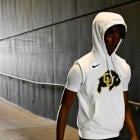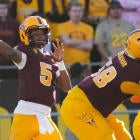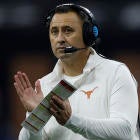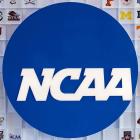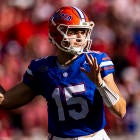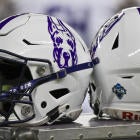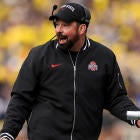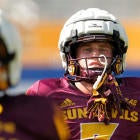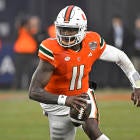The NCAA made its post-Ed O'Bannon trial arguments Tuesday, filing conclusions that were heavy on amateurism and a landmark Supreme Court ruling and included claims that the plaintiffs didn’t properly define markets under antitrust law.
In its 36-page brief, the NCAA used the word “amateurism” 46 times and cited the University of Oklahoma Board of Regents v. Oklahoma case on 22 occasions. U.S. District Judge Claudia Wilken previously said amateurism isn’t a useful word in this case and that the 1984 Supreme Court ruling in Board of Regents that ended the NCAA’s monopoly on football TV contracts isn’t applicable to the question of paying players.
Also, the NCAA addressed for the first time the plaintiffs’ 11 proposed injunctions if they win the case, saying they are “staggeringly broad” and should be rejected. If Wilken determines the NCAA illegally prevents Football Bowl Subdivision football players and Division I men’s basketball players from being paid for their names, images and likenesses (NIL), she will have to decide what exactly she is banning the NCAA from doing.
The plaintiffs would have to prove there is a less-restrictive alternative to the NCAA's current restraint. At the trial, Wilken discussed some of her own thoughts if there's an injunction, such as paying players through a trust fund for after they graduate or their eligibility expires; creating a salary cap or luxury tax; or paying athletes NIL money up to the cost of attendance.
The NCAA wrote that several of the plaintiffs’ proposals that would allow third parties to provide benefits directly to players “are inconsistent with earlier representations that bans on third-party payments were not at issue.” Other proposals allowing individual, instead of group licensing payments, are also inconsistent with the plaintiffs’ past claims, the NCAA said.
If Wilken determines the plaintiffs are entitled to an injunction, the NCAA asked for the chance for a full briefing to make arguments. The NCAA also asked Wilken to stay any injunction pending appeal -- the latest sign that this case won’t end even after Wilken’s expected ruling this summer. The O'Bannon plaintiffs filed their post-trial brief last week.
Can NCAA win issues related to markets?
Portions of the NCAA’s brief focused on a question Wilken struggled with at trial and asked the plaintiffs: Who’s the buyer and who’s the seller under antitrust theory? The NCAA wants to show the plaintiffs did not meet their burden under antitrust law in establishing markets of players for buying or selling their educational or licensing services.
The NCAA argued the proper antitrust claim is monopsony (a market with only one buyer), not monopoly (a market with a single seller) as cited by the plaintiffs. The plaintiffs have since said their claims are both a monopoly and a monopsony, yet they said it's irrelevant since the players are the harmed party either way.
The plaintiffs “made a tactical decision not to pursue a monopsony claim,” the NCAA wrote. “The word does not appear in their complaint or anywhere in their experts’ hundreds of pages of reports. … (The plaintiffs) cannot pursue this claim for the first time after trial. That, too, should be the end of the case.”
Michael Carrier, a distinguished professor at Rutgers Law School who followed the trial and read both parties post-trial briefs, said the NCAA likely needs to win in the early stages of Wilken's antitrust analysis that examines markets.
Wilken could be a precise judge who doesn’t believe a market has been defined precisely, Carrier said. If Wilken concludes that at least one of the plaintiffs’ markets has been harmed, she moves on to the question of whether any of the NCAA’s pro-competitive justifications outweigh the anti-competitive effects.
“I think the NCAA’s best hope is trap the plaintiffs on one of these initial stages,” Carrier said. “Once you get past that, I think the plaintiffs will have a much easier time with the pro-competitive justifications. My gut feel is the plaintiffs still have the better argument. I think the NCAA did not do a great job in trial.”
Carrier said the discussion over monopoly vs. monopsony goes to the heart of why the O’Bannon case is so nuanced. Are schools selling an education and the ability to play and athletes are buying? Or are the athletes selling their services to play and schools are buying?
“There’s a little truth to both,” Carrier said. “I always thought the monopsony argument was stronger for the plaintiffs because that puts the focus on the athletes actually selling something. But my sense is there’s enough that if the judge wants the plaintiffs to win, she could go either way on this."
Consumer impact
The NCAA argued in its brief that no harm has been shown to the consumer -- an element often seen in most antitrust cases. The NCAA wants to show the alleged restraint hasn’t affected the quantity or quality of output in any product market.
The NCAA cited deposition testimony by an expert of the plaintiffs, law professor Robert McCormick, who, according to the NCAA, testified that “the supply of athletes who could license their NIL is nearly perfectly inelastic, i.e., unaffected by whether athletes are paid for their NILs.”
Also, the NCAA defended testimony from one of its economic experts, Lauren Stiroh, that has been attacked by the plaintiffs, calling Stiroh's theories “well established in law and economics.” Stiroh testified that for an antitrust violation to occur, there must be an effect on the market that eventually impacts consumers.
Wilken said at the trial she thinks Stiroh’s theories are “actually wrong.” Carrier said in most antitrust cases consumers are effected, but he doesn’t think that’s necessary and disagreed with Stiroh.
The NCAA acknowledged “there is evidence of some demand for athletes’ NILs in video games,” noting that video-game manufacturer Electronic Arts makes games with names and faces of NBA and NFL players. But the NCAA, which recently settled a related video-game lawsuit for $20 million, said the plaintiffs did not show what other video games consumers would find to be reasonable substitutes for games with college players’ NILs.
In another argument, the NCAA said there is no market for licensing players’ NIL rights in video games because the NCAA and its schools would not license their own trademarks in games with players’ names.
“There is no use making a game with Alabama (players) if the game cannot show them playing for Alabama,” the NCAA wrote. “There also can be no ‘NCAA Basketball’ or ‘NCAA Football’ without the NCAA’s trademarks. It is undisputed that the NCAA and its members would not and will not license their indispensable (intellectual property) for use in video games that also use (players’) names and images.”
Question of NILs in TV broadcasts
The big prize in the O'Bannon case would be players getting a share of live television broadcast money moving forward. The NCAA identified testimony from more than a dozen of the named plaintiffs who said “they saw the opportunity to play college sports as a ‘privilege,’ knew their games were being televised, and welcomed this fact.”
The plaintiffs previously cited several examples in which they assert rights of publicity or NIL rights are explicitly referred to as part of the bundle of rights being licensed in TV contracts. The NCAA wrote that those agreements “simply identify which party will obtain any clearances if necessary.” The NCAA said many broadcast agreements expressly refer to NIL rights only for promoting games, not the live broadcast, and other TV contracts made no mention of NIL rights or clearances.
“Given that (plaintiffs’) theory is that the challenged rules set the ‘price’ for (athletes’) NILs at zero,” the NCAA wrote, “if there were actual market demand, then the purported transfer of rights should be ubiquitous and clear, not isolated and haphazard.”
The NCAA again argued that no state or judicial decision has ever recognized that it’s unlawful to show a participant in a live team sporting event on TV without his permission. The NCAA cited nine states with right-of-publicity laws, including California, that “expressly preclude right-of-publicity claims for the use of one’s NIL in the broadcast of a sporting event.”
Carrier said the NCAA’s discussion of amateurism, the Supreme Court, and live broadcast issues related to right of publicity and the First Amendment suggest the NCAA realizes there’s a good chance it might lose in District Court and is covering its bases for appeal.
As was the case at trial, the NCAA's post-trial brief spends considerable time defending amateurism, a term that goes to the heart of so many NCAA legal arguments. Unlike at the trial, the NCAA spent more time in its brief discussing the Supreme Court ruling from 1984.
The NCAA wrote the Supreme Court’s discussion about amateurism in the 1984 monopoly case over TV contracts is “binding authority” about how the NCAA defines its product. The NCAA cited a recent Seventh Circuit decision in an NCAA scholarship case that upheld that opinion.
The NCAA claimed it views itself as a “joint venture,” a term used by one of its economic experts, Daniel Rubinfeld, who has called the NCAA a cartel in his textbook. The plaintiffs' focus on whether the NCAA is a cartel and Rubinfeld's textbook definition of the word ignores "the long-standing antitrust principle that 'easy labels do not always supply ready answers,'" the NCAA wrote.
The NCAA said the 1984 Supreme Court decision “affirmed that restraints adopted by a joint venture that help to define the ‘unique characteristics’ of the venture’s product are subject to minimal antitrust scrutiny.”
Antitrust lawyer Jeff Shinder, a managing partner at the law firm Constantine Cannon in New York, said the NCAA is significantly banking on amateurism and the 1984 Supreme Court ruling for appeals. Shinder said Wilken was right to disregard the Supreme Court decision in this case given how college sports has changed in 30 years.
“The NCAA, as far as I can see, doesn't answer why it’s necessary to protect amateurism with a complete restraint on players’ ability to license their rights,” Shinder said. “I do think the plaintiffs have a good case, and this case could be framed in different ways. It could have more frontally taken on the Holy Grail question: Should these athletes be paid?”
In regard to internal NCAA documents from trial that reflected debates about whether college sports are too commercialized, the NCAA argued that doesn’t show disagreement between the NCAA and schools about amateurism. The question of commerical exploitation is different than the question of whether college sports are amateur, according to the NCAA.
“Essentially, (plaintiffs’) allegations about exploitation are complaints that the NCAA and its member schools may not always live up to all of their ideals, including goals that go above and beyond the core definition of amateurism,” the NCAA wrote. “Even if those accusations were true, it would mean only that the NCAA and its member schools should work harder to better implement their own goals and ideals. It would not mean that amateurism should be banned.”
The O’Bannon plaintiffs get another chance to respond to the NCAA’s brief. Then the decision rests with Wilken.












